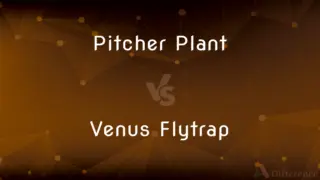Cell Membrane vs. Plasma Membrane — What's the Difference?
By Tayyaba Rehman — Published on November 28, 2023
Cell Membrane and Plasma Membrane are terms often used interchangeably to refer to the lipid bilayer that encloses the cell, separating it from the extracellular environment.

Difference Between Cell Membrane and Plasma Membrane
Table of Contents
ADVERTISEMENT
Key Differences
The cell membrane serves as the boundary of the cell, maintaining the integrity of its internal environment and regulating the substances that move in and out of the cell. On the other hand, the plasma membrane, while it is fundamentally similar, the term is often used particularly in the context of animal cells.
Cell Membrane is composed of a phospholipid bilayer embedded with proteins and other molecules to facilitate transport and communication. Plasma Membrane regulates what enters and exits the cell, ensuring the internal environment remains stable and distinct from the external environment, crucial for maintaining homeostasis.
Comparison Chart
Definition
Encloses the cell's cytoplasm
Surrounds the cell’s contents
Composition
Phospholipid bilayer
Primarily a lipid bilayer
Functions
Regulates transport
Controls substance exchange
ADVERTISEMENT
Associated Cells
All cell types
Often associated with animal cells
Key Role
Maintaining cellular integrity
Ensuring cellular homeostasis
Compare with Definitions
Cell Membrane
It is the outermost covering of animal cells, providing structural support.
The cell membrane maintains the integrity and shape of animal cells.
Plasma Membrane
Comprising lipids and proteins, the plasma membrane ensures cellular integrity.
The structure of the plasma membrane allows it to dynamically control its shape and interactions.
Cell Membrane
The cell membrane involves a lipid bilayer interspersed with proteins.
The lipid bilayer of the cell membrane ensures that it is selectively permeable.
Plasma Membrane
The plasma membrane encapsulates cellular components and controls substance passage.
Nutrients enter a cell, and waste products exit through the plasma membrane.
Cell Membrane
The cell membrane is a semi-permeable barrier that encloses a cell's contents.
The cell membrane regulates the passage of substances into and out of the cell.
Plasma Membrane
The plasma membrane has a role in identifying the cell to the immune system.
Antigens presented on the plasma membrane help the immune system distinguish self from non-self.
Cell Membrane
The cell membrane participates in cell signaling and communication.
Receptors on the cell membrane receive signals from other cells to initiate responses.
Plasma Membrane
Functionally, the plasma membrane maintains the electrochemical gradient across the cell.
Ions are actively and passively transported across the plasma membrane, managing the cell's electrical charge.
Cell Membrane
The cell membrane isolates the cell’s internal environment from its exterior.
Despite the external changes, the cell membrane stabilizes the internal conditions of the cell.
Plasma Membrane
The plasma membrane is vital for communication between cells in multicellular organisms.
The plasma membrane carries receptors that detect signals, facilitating intercellular communication.
Cell Membrane
The semipermeable membrane enclosing the cytoplasm of a cell.
The cell membrane controls the movement of substances in and out of the cell.
Plasma Membrane
A selective barrier that separates the cell’s internal structures from the external environment.
The plasma membrane maintains the cell’s homeostasis by regulating substance exchange.
Common Curiosities
What is the primary function of the Cell Membrane?
It regulates the transport of substances into and out of the cell.
Is the composition of the Plasma Membrane and Cell Membrane the same?
Yes, both comprise a phospholipid bilayer with embedded proteins.
Are the terms Cell Membrane and Plasma Membrane synonymous?
Yes, they are often used interchangeably in cellular biology contexts.
Is the Plasma Membrane visible under a light microscope?
Typically, the plasma membrane is too thin to be distinctly visible under a light microscope.
Can all cells be said to have a plasma membrane?
Yes, all cells, prokaryotic and eukaryotic, have a form of a plasma/cell membrane.
Do both the Plasma Membrane and Cell Membrane facilitate communication between cells?
Yes, they allow signaling molecules to pass between cells, enabling communication.
How does the Plasma Membrane protect the cell?
It acts as a barrier, protecting the cell from its external environment and regulating entry and exit of substances.
Is the Plasma Membrane involved in recognizing signals from other cells?
Yes, receptor proteins in the plasma membrane identify and receive signals, facilitating intercellular communication.
Does the Cell Membrane have an asymmetrical distribution of lipids and proteins?
Yes, the distribution of lipids and proteins is asymmetrical and arranged according to function and necessity.
Can substances freely move across the Cell Membrane?
No, the cell membrane is selectively permeable, only allowing specific substances through.
How does the Cell Membrane contribute to maintaining cellular homeostasis?
The cell membrane selectively allows substances in and out, maintaining a stable internal environment.
What role do proteins play in the functionality of the Cell Membrane?
Proteins assist in various functions, including transport, cell adhesion, and receiving signals.
Are the concepts of the Cell Membrane and Plasma Membrane studied in both plant and animal cell biology?
Yes, while the terminology may vary slightly, the concepts are vital in understanding both plant and animal cell biology.
How does the structure of the Plasma Membrane facilitate its function?
Its phospholipid bilayer allows selective permeability, while embedded proteins assist various functions like transport and signaling.
Can the Plasma Membrane repair itself?
Yes, the plasma membrane has a self-healing capability where it can reseal minor damage automatically.
Share Your Discovery

Previous Comparison
Pitcher Plant vs. Venus Flytrap
Next Comparison
Acid-Base Titration vs. Redox TitrationAuthor Spotlight
Written by
Tayyaba RehmanTayyaba Rehman is a distinguished writer, currently serving as a primary contributor to askdifference.com. As a researcher in semantics and etymology, Tayyaba's passion for the complexity of languages and their distinctions has found a perfect home on the platform. Tayyaba delves into the intricacies of language, distinguishing between commonly confused words and phrases, thereby providing clarity for readers worldwide.












































